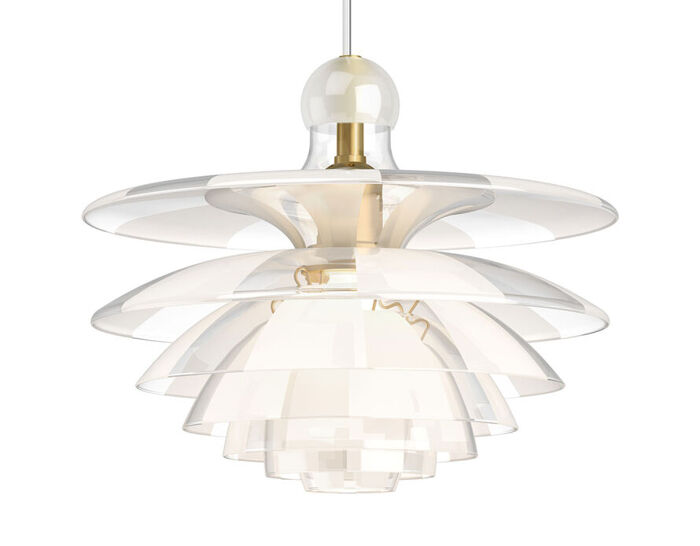PH Septima
by Poul Henningsen from Louis Poulsen
ph septima
Design Poul Henningsen, 1928
Clear, sand-blasted glass, raw brass
Made in Denmark by Louis Poulsen
Poul Henningsen's Septima is a brilliant, iconic glass pendant. Seven glass shades are formed and spaced in accordance with Henningsen's shade 3-shade design. The glass shades are thin yet robust. Each shade has an alternating pattern of clear glass and sandblasted segments. Frosted glass fields alternately cover the clear ones from shade-to-shade, thus diffusing the light even more softly. The internal frame and canopy are made of untreated brass intended to develop a patina over time.
The PH Septima is regarded as one of Poul Henningsen's most refined pendants. When it was exhibited for the first time as a prototype at the Danish Museum of Decorative Art (now "Designmuseum Danmark") in 1928, the poetic piece was publicly applauded. Based on Henningsen's three-shade system, the glass crown has four extra shades inserted between the three basic shades - all seven produced in very delicate, but robust, Italian borosilicate glass. The shades made of clear glass are treated to appear with alternating clear and frosted fields and are positioned so that the frosted fields cover the clear fields underneath, allowing the shades to spread the light in a more diffused manner while maintaining glare-free, downwardly directed light distribution. In addition, a neat round glass cup is placed at the top to prevent dust, etc. from falling into the lamp. In 1931, a smaller version, PH Septima 4, was launched based on the shade sizes from the PH 4/4 lamp, whereas the original PH Septima 5 is based on shade sizes from the PH 5/5. During the development of the PH Septima, Henningsen designed a metal version as well, but it never reached production. The drawings, however, formed the basis for the development of the PH Artichoke, designed around three decades later, for the Langelinie Pavilion in Copenhagen. In the 1940s, however, the esteemed PH Septima went out of production along with numerous other lamps due to a shortage of raw materials. In 2020, Louis Poulsen brings back Henningsen's sophisticated seven-shade glass crown, based on the PH Septima 5, with optimized suspension and enhanced glass for better endurance and stability.
* untreated brass canopy and shade supports
* untreated brass will patina over time
* mounts over 4" octagonal outlet box (requires additional weight support)
* includes a single stainless steel aircraft wire for support
15.9" h | 19.7" dia | white fabric cord: 144" | IP20
light source: 1x 22W E26 bulb (not included)
dimmable (dimmer not included, please reference manufacturer's specifications)
Clear, sand-blasted glass, raw brass
Made in Denmark by Louis Poulsen
Poul Henningsen's Septima is a brilliant, iconic glass pendant. Seven glass shades are formed and spaced in accordance with Henningsen's shade 3-shade design. The glass shades are thin yet robust. Each shade has an alternating pattern of clear glass and sandblasted segments. Frosted glass fields alternately cover the clear ones from shade-to-shade, thus diffusing the light even more softly. The internal frame and canopy are made of untreated brass intended to develop a patina over time.
The PH Septima is regarded as one of Poul Henningsen's most refined pendants. When it was exhibited for the first time as a prototype at the Danish Museum of Decorative Art (now "Designmuseum Danmark") in 1928, the poetic piece was publicly applauded. Based on Henningsen's three-shade system, the glass crown has four extra shades inserted between the three basic shades - all seven produced in very delicate, but robust, Italian borosilicate glass. The shades made of clear glass are treated to appear with alternating clear and frosted fields and are positioned so that the frosted fields cover the clear fields underneath, allowing the shades to spread the light in a more diffused manner while maintaining glare-free, downwardly directed light distribution. In addition, a neat round glass cup is placed at the top to prevent dust, etc. from falling into the lamp. In 1931, a smaller version, PH Septima 4, was launched based on the shade sizes from the PH 4/4 lamp, whereas the original PH Septima 5 is based on shade sizes from the PH 5/5. During the development of the PH Septima, Henningsen designed a metal version as well, but it never reached production. The drawings, however, formed the basis for the development of the PH Artichoke, designed around three decades later, for the Langelinie Pavilion in Copenhagen. In the 1940s, however, the esteemed PH Septima went out of production along with numerous other lamps due to a shortage of raw materials. In 2020, Louis Poulsen brings back Henningsen's sophisticated seven-shade glass crown, based on the PH Septima 5, with optimized suspension and enhanced glass for better endurance and stability.
* untreated brass canopy and shade supports
* untreated brass will patina over time
* mounts over 4" octagonal outlet box (requires additional weight support)
* includes a single stainless steel aircraft wire for support
15.9" h | 19.7" dia | white fabric cord: 144" | IP20
light source: 1x 22W E26 bulb (not included)
dimmable (dimmer not included, please reference manufacturer's specifications)
Poul Henningsen
Poul Henningsen practiced traditional functionalistic architecture. This led him to focus on what he would become most well-known for; lighting. During the German occupation he became part of a Danish colony of artists living in Sweden.
Louis Poulsen designs are based on the principle that form follows function. Innovative designs and quality materials are instrumental in producing Louis Poulsen iconic lighting.














 write a review now
write a review now
